The seven essential tools for crafting perfect hand-mixed beauty bars include mini mixing bowls, wooden spoons, silicone spatulas, stainless steel whisks, precision measuring instruments, hand-carved mixing paddles, and vintage copper bowls. You'll find wooden tools offer natural antimicrobial properties, while silicone resists heat and chemicals. Stainless steel provides durability for lye solutions, and copper regulates temperature beautifully. These time-tested implements connect you to traditional artisanal methods while ensuring your creations achieve professional-quality results every time.
7 Time-Tested Tools for Hand-Mixed Beauty Bars
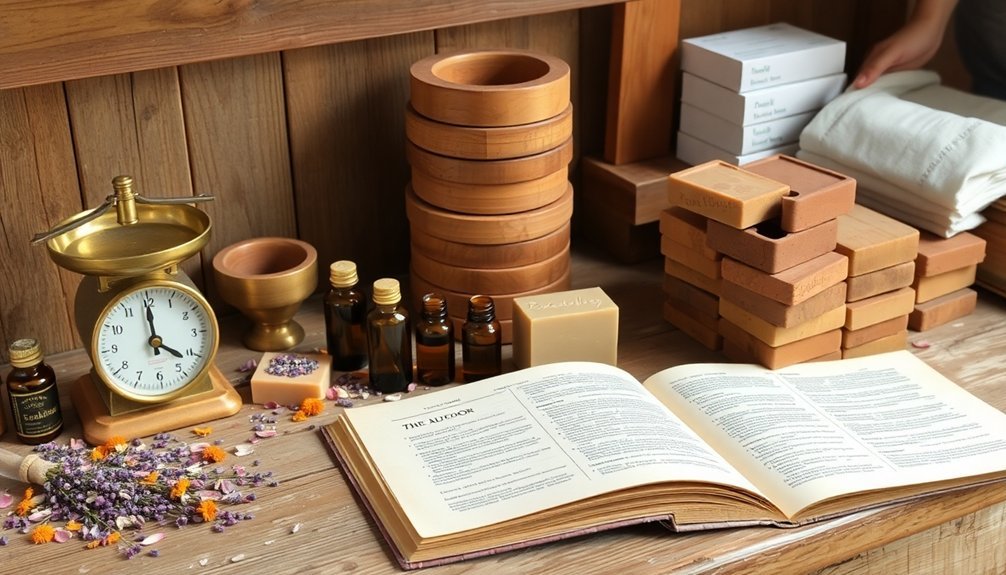
Artisans of beauty have long relied on specialized tools to create perfect hand-mixed beauty bars. Your toolkit should include mini mixing bowls ideal for small-batch customization and precise measuring instruments that guarantee consistent quality in every bar.
Hand whisks are essential for achieving thorough ingredient integration and smooth textures. When you're juggling multiple tasks, tint mixing rings provide hands-free convenience, allowing for precise application. These glass rings are durable and hygienic, making them perfect for regular use in busy salon environments.
Don't underestimate the importance of proper sanitizing solutions—they maintain hygiene standards and prevent contamination.
For best results, look for user-friendly designs with ergonomic grips that reduce strain during extended mixing sessions. Many traditional tools now come with modern enhancements like temperature control features to improve the consistency and longevity of your beauty bars.
Wooden Spoons: The Artisan's First Choice
Among all the tools in a beauty bar crafter's collection, wooden spoons stand as the cornerstone for good reason.
They're remarkably durable, handling thick mixtures without breaking while resisting high temperatures that would melt plastic alternatives.
You'll appreciate how these non-reactive tools won't leach chemicals into your delicate formulations or scratch your mixing vessels. The naturally germ-killing properties of wood make these utensils particularly suitable for beauty product preparation. Their insulating properties keep your hands comfortable during extended mixing sessions.
When crafting beauty bars, you need utensils that preserve the integrity of your ingredients. Wooden spoons deliver this while offering sustainable benefits—they're biodegradable and made from renewable resources.
Their gentle nature on surfaces extends the life of your equipment, while their ability to subtly retain flavors can add unique character to your creations.
Silicone Spatulas: Flexible Friends for Perfect Blending
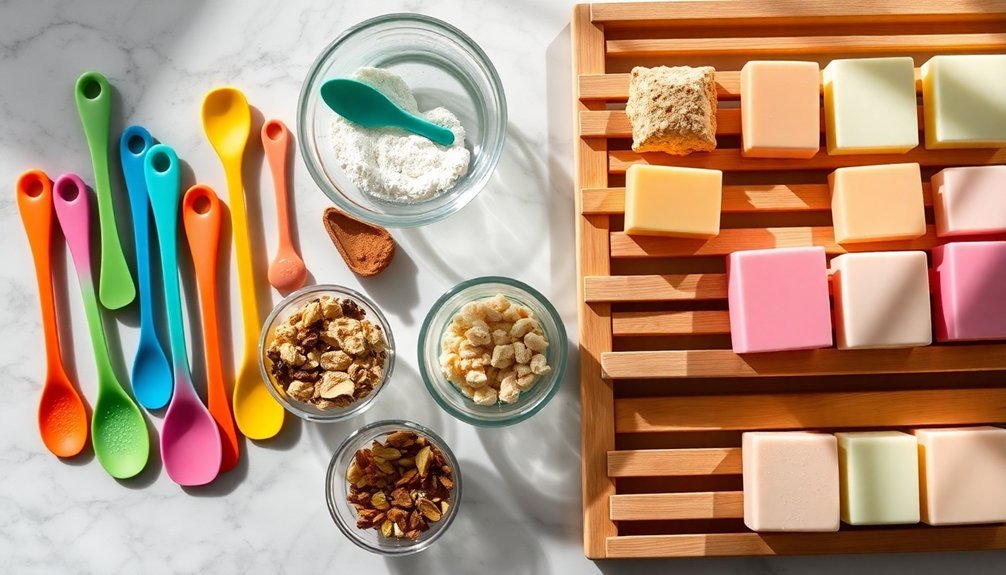
You'll appreciate silicone spatulas for their remarkable ability to scrape every corner of your mixing bowl, ensuring no precious ingredients go to waste.
Their heat-resistant properties allow you to blend hot oils and butters without warping or releasing harmful chemicals into your beauty bars.
The flexible material contours perfectly to curved surfaces, making them ideal tools for thoroughly incorporating all your ingredients into a smooth, consistent blend. These tools provide precise application of your beauty bar mixtures, minimizing waste and allowing for controlled distribution of product.
Scrape Every Corner
Three essential qualities make silicone spatulas indispensable for any beauty bar creator: efficiency, precision, and hygiene.
When mixing your custom beauty formulations, you'll waste less product and create more consistent results with these flexible tools. Available in green and white colors, they're designed specifically for mixing, applying, and scraping beauty products.
- Maximum extraction – You'll get every last drop from containers, reducing waste and saving money on expensive ingredients.
- Gentle application – The soft silicone won't scratch delicate skin when applying your creations directly.
- Easy cleanup – Unlike wooden tools, silicone spatulas won't harbor bacteria and can be quickly sanitized between uses.
- Versatile mixing – Whether you're working with thick mud masks or delicate eye serums, the flexible edge adapts to different consistencies and container shapes.
Heat-Resistant Flexibility
Silicone spatulas offer more than just effective mixing capabilities—they withstand the extreme temperatures often required in beauty formulation. Their impressive resistance range (-40°F to 482°F) means you can smoothly fold in cool butter or stir hot oils without worrying about melting or warping your tools.
You'll appreciate that high-quality food-grade silicone won't leach chemicals or alter the scent profile of your beauty bars. Their non-reactive nature preserves the integrity of essential oils and fragrances in your formulations.
When working with delicate ingredients, these flexible tools gently scrape every corner of your mixing bowl without scratching surfaces. Unlike plastic alternatives, silicone spatulas retain their shape and performance through hundreds of uses.
Their non-porous surface resists staining and odor absorption—critical when crafting multiple scent varieties.
Stainless Steel Whisks: Creating Texture Without Contamination
The humble stainless steel whisk plays a critical role in creating perfectly textured beauty bars while maintaining product purity. When you're handling caustic ingredients like sodium hydroxide, your tools must withstand chemical interactions without compromising your final product.
- Chemical resistance makes stainless steel whisks ideal for lye solutions that would damage plastic alternatives, ensuring no contamination affects your beauty bars.
- Heat tolerance allows you to work with both hot and cold process methods without worrying about tool degradation.
- Efficient mixing helps you achieve consistent texture when a stick blender isn't available or preferred.
- Longevity makes these tools cost-effective despite higher upfront investment compared to plastic alternatives.
You'll appreciate how these durable tools provide peace of mind through countless batches without reaction or residue. Their easy to clean design ensures that no residue remains between batches, further protecting your product integrity.
Cold Process Stirrers: Tradition Meets Precision
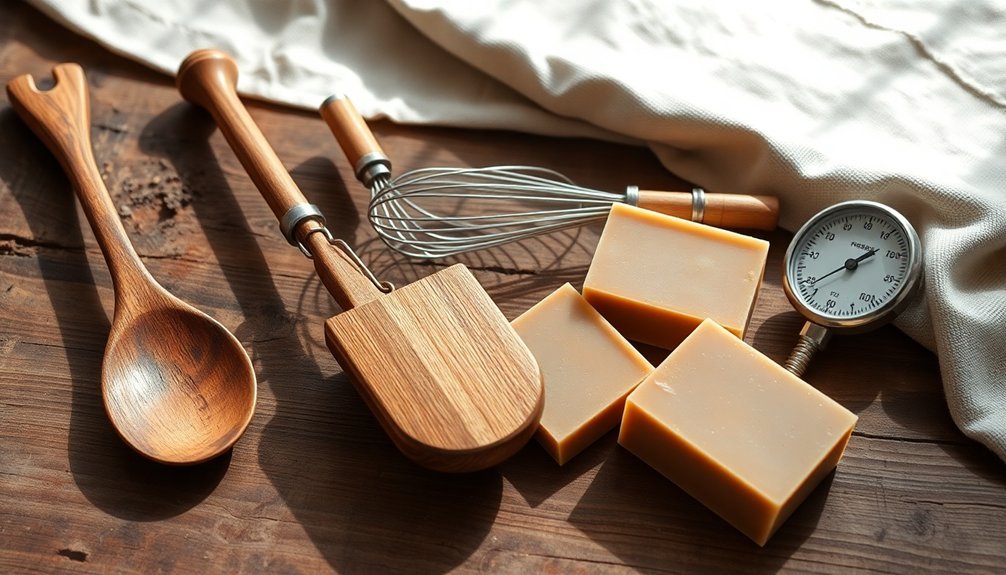
When mixing cold process soap, you'll need to choose between traditional wooden stirrers that minimize air incorporation and modern silicone options that resist lye damage.
You'll find your perfect mixing rhythm by starting slowly at the edges of your container, then gradually increasing your pace as the mixture begins to thicken.
Whether you prefer hand-stirring's meditative control or the efficiency of a stick blender on low speed, maintaining a consistent technique will help you achieve the smooth, creamy texture that characterizes quality handcrafted soap. A stick blender significantly reduces mixing time from hours to minutes, making it an invaluable tool for serious soap makers.
Wooden vs. Silicone Options
Choosing between wooden and silicone tools represents one of the most fundamental decisions you'll make in your cold process soap-making journey. Each material offers distinct advantages depending on your specific needs and soap-making style.
- Durability considerations: While wooden tools may degrade with repeated exposure to soap and water, silicone options maintain their integrity longer and clean up more easily.
- Temperature tolerance: Silicone withstands various temperatures, but avoid using wooden tools in hot processes where they might warp or burn. Silicone molds can develop bubble patterns on soap surfaces when overheated during processing.
- Precision vs. tradition: Wooden spoons offer simplicity and tradition but less precision; silicone provides smoother finishes and more accurate results.
- Cost and customization: Wooden tools tend to be more economical for large-scale production and allow for easier customization, while silicone excels in creating consistently shaped products.
Perfect Mixing Rhythm
Finding your perfect mixing rhythm stands at the heart of successful cold process soap making, where tradition and modern precision tools now work together harmoniously.
When mixing, blend in short bursts with your stick blender, then stir manually between pulses. This prevents excessive thickening while achieving that vital "trace" – when your mixture holds patterns when drizzled onto itself.
Keep your blender on low speed to maintain control and avoid over-mixing. Most recipes reach trace within minutes, but timing varies based on your ingredients and their temperature. Always aim for proper saponification to ensure your oils and lye fully transform into soap.
Monitor this process with an infrared thermometer to prevent issues like "alien brain" or soda ash formation. Remember that continuous blending can overheat your stick blender's motor and accelerate thickening beyond your control, potentially ruining intricate design plans.
Hand-Carved Mixing Paddles: Craftsmanship in Every Stroke
Artisans dedicated to beauty bar creation understand that the tools shape the final product just as much as the ingredients themselves. Your hand-carved wooden paddle becomes an extension of your artistry, offering durability and precision while preserving the integrity of your beauty bars.
These time-tested tools deliver advantages that modern alternatives can't match:
- Non-reactive properties guarantee your ingredients remain pure and uncontaminated
- Heat resistance prevents overheating delicate mixtures during vital blending phases
- Ergonomic designs reduce fatigue during extended mixing sessions
- Sustainable materials align with eco-conscious beauty production values
The unique character of each hand-carved paddle reflects the same dedication to craftsmanship you pour into your beauty bars, creating a harmonious connection between artisan and instrument. With an extra-long length of 36 inches, these paddles excel at handling large batches of beauty bar ingredients, allowing for efficient production without sacrificing quality.
Vintage Copper Mixing Bowls: The Temperature-Sensitive Companion
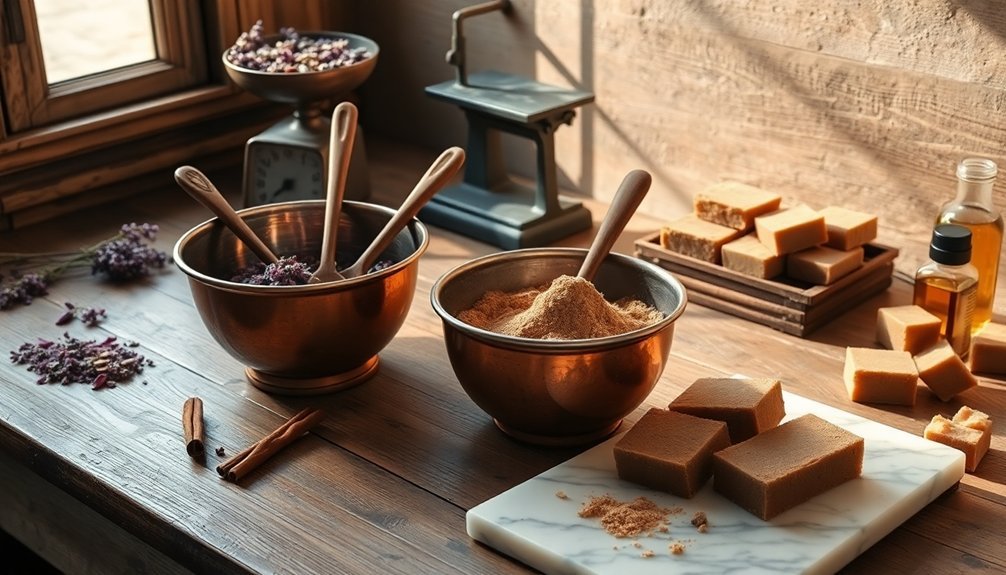
While the artisan's paddle guides the mixing journey, the vessel that holds your premium ingredients plays an equally important role.
Vintage copper mixing bowls offer unmatched temperature regulation for your beauty bar creations, conducting heat efficiently while their substantial thickness provides stability.
You'll appreciate how these bowls respond to temperature needs—whether melting sensitive ingredients or maintaining cool conditions for delicate oils. Their antimicrobial properties guarantee your products remain pure, while the naturally developing patina adds authentic charm to your crafting process.
The rolled rims and brass loops aren't just decorative; they enhance functionality during intensive mixing sessions. Many artisans prefer vintage options with riveted brass rings for added durability during heavy mixing.
Though they require special care to maintain their luster, the emotional connection you'll develop with these timeless tools transforms routine mixing into an experience that honors traditional craftsmanship with every beauty bar you create.
Frequently Asked Questions
How Do I Prevent My Beauty Bars From Sweating?
Apply antiperspirants to your hands before mixing beauty bars. You'll reduce moisture by using absorbent powders, maintaining cool temperatures, and thoroughly drying your hands. Consider natural remedies like sage tea soaks for extra protection.
Can I Substitute Plastic Tools for Traditional Wooden Ones?
Yes, you can substitute plastic tools for wooden ones. They're easier to clean and reusable, while wooden tools offer better grip. Your choice depends on your preference and sustainability priorities.
How Often Should Mixing Tools Be Replaced?
You should replace mixing tools when they show visible wear, typically every 3-6 months for wooden tools and 6-12 months for plastic or metal ones. Don't wait until they're deteriorating or harboring bacteria.
Are There Allergen Concerns With Certain Mixing Materials?
Yes, you should be concerned about allergens in mixing materials. Metal tools may leach nickel, while wooden ones can absorb allergens. Silicone and glass tools are typically safer alternatives for sensitive formulations.
What's the Ideal Room Temperature for Hand-Mixing Beauty Bars?
You'll want to maintain 65-75°F when hand-mixing beauty bars. This temperature range keeps waxes and oils manageable while preventing crystallization issues. It's also comfortable for you during the mixing process.
In Summary
You'll find that investing in these time-tested tools transforms your beauty bar creation process. They're not just implements—they're extensions of your craft. Whether you're a beginner or seasoned artisan, these seven tools support your journey toward perfect consistency and texture. Don't underestimate the value of quality equipment; it's the difference between good bars and extraordinary ones. Your hands and these tools—that's all you need.

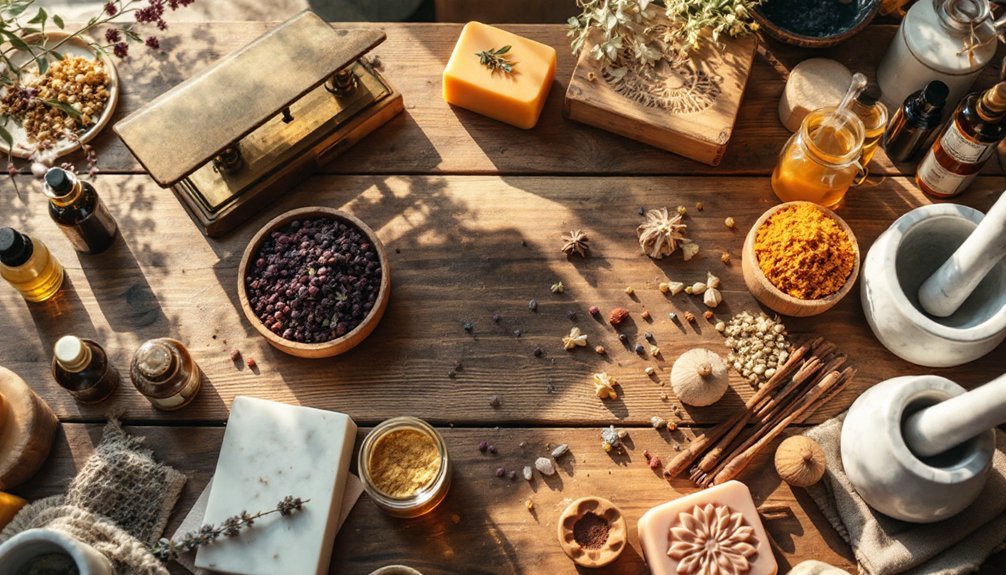



Leave a Reply